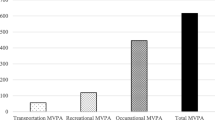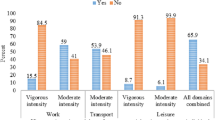Abstract
Objectives
The goal of this study was to compare the odds of meeting physical activity (PA) guidelines among adults living in rural and urban areas of Canada.
Methods
Data from the 2017 cycle of the Canadian Community Health Survey were analyzed using binomial logistic regression with a sample of 47,266 adults representing a survey-weighted total of 25,669,018. The odds of meeting PA guidelines were determined based on self-reported moderate-to-vigorous PA (<150 min per week or ≥150 min per week). Communities were categorized as urban or rural based on population size and density. Individual-level correlates included in the model were self-identified sex, age, body mass index, highest level of education, household income, perceived health, and sense of belonging to community.
Results
Approximately 56.6% of rural and 59.3% of urban adults reported meeting recommended PA levels when location was examined as a sole predictor. The best-fit model adjusted for all individual-level factors showed a significant sex × location interaction. Males in rural communities were more likely to report meeting PA guidelines (odds = 0.90 or 47.4%) than males in urban areas (odds = 0.78 or 43.8%), whereas females living in rural communities (odds = 0.58 or 36.7%) were less likely to report meeting PA guidelines than females in urban areas (odds = 0.65 or 39.4%).
Conclusion
The association between rural-urban residence and meeting PA guidelines appears to be contingent on self-identified sex differences. Future work should explore how gender- and location-related variables interact to influence self-reported PA engagement.
Résumé
Objectifs
Le but de cette étude était de comparer les probabilités de respecter les recommandations en matière d’activité physique (AP) liées à la santé de la population chez les adultes vivant dans les communautés rurales et urbaines du Canada.
Méthodes
Les données du cycle 2017 de l’Enquête sur la santé dans les collectivités canadiennes ont été analysées à l’aide de régressions logistiques binomiales avec un échantillon pondéré de 47 266 participants adultes représentant 25 669 018 adultes. Les probabilités de respecter les lignes directrices de l’AP ont été déterminées en fonction de l’AP modérée à vigoureuse déclarée (<150 minutes par semaine ou ≥150 minutes par semaine) et les communautés ont été classées comme urbaines ou rurales selon la taille et la densité de la population. Les corrélats au niveau individuel inclus dans le modèle étaient les suivants : sexe auto-identifié, âge, indice de masse corporelle, niveau de scolarité le plus élevé, revenu du ménage, état de santé autoévalué et sentiment d’appartenance à la communauté.
Résultats
Environ 56,6 % des adultes vivant en milieu rural et 59,3 % des adultes en milieu urbain ont déclaré avoir atteint les niveaux d’AP recommandés lorsque l’emplacement a été examiné comme seul prédicteur de l’activité. Le meilleur modèle après ajustement pour tous les facteurs au niveau individuel a révélé une interaction significative entre les variables sexe x emplacement. Les hommes des communautés rurales étaient plus susceptibles de déclarer respecter les directives d’AP (odds = 0,90 ou 47,4 %) que ceux des zones urbaines (odds = 0,78 ou 43,8 %), tandis que les femmes vivant dans les communautés rurales (odds = 0,58 ou 36,7 %) étaient moins susceptibles de déclarer avoir respecté les directives d’AP par rapport à celles des communautés urbaines (odds = 0,65 ou 39,4 %).
Conclusion
L’association entre la ruralité d’une communauté et la déclaration des AP semble dépendre des différences sexuelles auto-identifiées. Les travaux futurs devraient explorer comment les variables liées au sexe et au lieu interagissent pour influencer la participation rapportée des Canadiens aux taux AP rapportés.

Similar content being viewed by others
Data availability
Access to these data is through Statistics Canada.
Notes
Note that the optimal fitted regression model is anchored to activity in the winter season (data collection period January–March), accounting for the generally lower rates of physical activity participation in the final fitted model in comparison with the base model.
References
Carnahan, L. R., Zimmermann, K., Khare, M. M., Paulsey, E., Molina, Y., Wilbur, J., & Geller, S. E. (2018). Physical activity and masculinity in rural men: A qualitative study of men recruited from churches. Health Education Research, 33(2), 145–154. https://doi.org/10.1093/her/cyy002.
Clarke, J., Colley, R., Janssen, I. & Tremblay, M.S. (2019). Accelerometer-measured moderate-to-vigorous physical activity of Canadian adults, 2007 to 2017. Statistics Canada Health Reports. https://doi.org/10.25318/82-003-x201900800001-eng. Accessed 13 Oct 2020.
Cleland, V. J., Ball, K., King, A. C., & Crawford, D. (2012). Do the individual, social, and environmental correlates of physical activity differ between urban and rural women? Environment & Behavior, 44(3), 350–373.
Colley, R. C., Butler, G., Garriguet, D., Prince, S. A., & Roberts, K. C. (2018). Comparison of self-reported and accelerometer-measured physical activity in Canadian adults. Health Reports, 29(12), 3–15.
Fan, J. X., Wen, M., & Kowaleski-Jones, L. (2014). Rural-urban differences in objective and subjective measures of physical activity: Findings from the National Health and Nutrition Examination Survey (NHANES) 2003-2006. Preventing Chronic Disease, 11, E141.
Forbes, C. C., Yu, Z. M., Cui, Y., DeClercq, V., Grandy, S. A., Parker, L., Sweeney, E., Dummer, T. J. B., & Keats, M. R. (2020). Rural-urban disparities in total physical activity, body composition, and related health indicators: An Atlantic PATH Study. The Journal of Rural Health, 36(1), 111–119.
Gavarkovs, A. G., Burke, S. M., & Petrella, R. J. (2017). The physical activity–related barriers and facilitators perceived by men living in rural communities. American Journal of Men's Health, 11(4), 1130–1132.
Gorber, S. C., Tremblay, M., Moher, D., & Gorber, B. (2007). A comparison of direct vs. self-report measures for assessing height, weight and body mass index: a systematic review. Obesity Reviews, 8(4), 307–326. https://doi.org/10.1111/j.1467-789X.2007.00347.x.
Hiebert, B., Leipert, B., Regan, S., & Burkell, J. (2018). Rural men’s health, health information seeking, and gender identities: A conceptual theoretical review of the literature. American Journal of Men’s Health, 12(4), 863–876. https://doi.org/10.1177/1557988316649177.
Kaplan, M. S., Newsom, J. T., McFarland, B. H., & Lu, L. (2001). Demographic and psychosocial correlates of physical activity in late life. American Journal of Preventive Medicine, 21(4), 306–312.
McGannon, K. R., Busanich, R., Witcher, C. S., & Schinke, R. J. (2014). A social ecological exploration of physical activity influences among rural men and women across life stages. Qualitative research in sport, exercise and health, 6(4), 517–536.
Merchant, A. T., Dehghan, M., & Akhtar-Danesh, N. (2007). Seasonal variation in leisure-time physical activity among Canadians. Canadian Journal of Public Health, 98, 203–208. https://doi.org/10.1007/BF03403713.
Pan, S.Y., Cameron, C., DesMeules, M. et al. (2009). Individual, social, environmental, and physical environmental correlates with physical activity among Canadians: A cross-sectional study. BMC Public Health, 9. DOI: https://doi.org/10.1186/1471-2458-9-21.
Parks, S. E., Housemann, R. A., & Brownson, R. C. (2003). Differential correlates of physical activity in urban and rural adults of various socioeconomic backgrounds in the United States. Journal of Epidemiology & Community Health, 57(1), 29–35.
Patterson, K. A., Cleland, V., Venn, A., Blizzard, L., & Gall, S. (2014). A cross-sectional study of geographic differences in health risk factors among young Australian adults: The role of socioeconomic position. BMC Public Health, 14, 1278. https://doi.org/10.1186/1471-2458-14-1278.
Perrin, A. J., Caren, N., Skinner, A. C., Odulana, A., & Perrin, E. M. (2016). The unbuilt environment: Culture moderates the built environment for physical activity. BMC public health, 16(1), 1–8.
Plotnikoff, R. C., Mayhew, A., Birkett, N., Loucaides, C. A., & Fodor, G. (2004). Age, gender, and urban–rural differences in the correlates of physical activity. Preventive Medicine, 39(6), 1115–1125.
Rhodes, R. E., Saelens, B. E., & Sauvage-Mar, C. (2018). Understanding physical activity through interactions between the built environment and social cognition: A systematic review. Sports Medicine, 48(8), 1893–1912.
Sriram, U., Morgan, E. H., Graham, M. L., Folta, S. C., & Seguin, R. A. (2018). Support and sabotage: A qualitative study of influences on health behaviors among rural adults. Journal of Rural Health, 34(1), 88–97. https://doi.org/10.1111/jrh.12232.
Statistics Canada. (2018). 2018 Canadian Community Health Survey user guide. Ottawa: Statistics Canada.
Tremblay, M. S., Warburton, D. E., Janssen, I., Paterson, D., Latimer, A. E., Rhodes, R. E., Kho, M. E., Hicks, A., LeBlanc, A. G., Zehr, L., Murumets, K., & Duggan, M. (2011). New Canadian physical activity guidelines. Applied Physiology, Nutrition & Metabolism, 36(1), 36–46. https://doi.org/10.1139/H11-009.
Trost, S. G., Bauman, A. E., Sallis, J. F., & Brown, W. (2002). Correlates of adults’ participation in physical activity: Review and update. Medicine and Science in Sports and Exercise, 34(12), 1996–2001.
Warburton, D. E. R., & Bredin, S. S. D. (2017). Health benefits of physical activity: A systematic review of current systematic reviews. Current Opinions in Cardiology, 32(2), 541–556. https://doi.org/10.1097/HCO.0000000000000437.
Wilcox, S., Castro, C., King, A. C., Housemann, R., & Brownson, R. C. (2000). Determinants of leisure time physical activity in rural compared with urban older and ethnically diverse women in the United States. Journal of Epidemiology & Community Health, 54(9), 667–672.
Witcher, C. S., Holt, N. L., Young, W., Blanchard, C., Murnaghan, D., & Spence, J. C. (2016). Physical activity perceptions and influences among older adults in rural Nova Scotia. Canadian Journal of Aging, 35(1), 115–129. https://doi.org/10.1017/S0714980815000598.
Yip, C., Sarma, S., & Wilk, P. (2016). The association between social cohesion and physical activity in Canada: A multilevel analysis. SSM-population health, 2, 718–723.
Zhang, Z. (2016). Residuals and regression diagnostics: Focusing on logistic regression. Annals of Translational Medicine, 4(10), 195–202. https://doi.org/10.21037/atm.2016.03.36.
Code availability
The syntax used in this analysis may be available upon reasonable request.
Funding
This study was funded by a Research Data Centre award from the University of Northern British Columbia.
Author information
Authors and Affiliations
Contributions
All the authors were involved in conception and design of the study. Statistical analysis was completed by NW. CP led the preparation of the manuscript, which was reviewed by all authors.
Corresponding author
Ethics declarations
Ethics approval
Canadian Community Health Survey (CCHS) data were obtained through the Research Data Centre at the University of Northern British Columbia according to guidelines established by Statistics Canada.
Consent to participate
All participants who complete the Canadian Community Health Survey provide informed consent.
Consent for publication
Not applicable.
Conflict of interest
The authors declare no competing interests.
Additional information
Publisher’s note
Springer Nature remains neutral with regard to jurisdictional claims in published maps and institutional affiliations.
Rights and permissions
About this article
Cite this article
Pelletier, C.A., White, N., Duchesne, A. et al. Likelihood of meeting physical activity guidelines in rural and urban adults: cross-sectional analysis of the Canadian Community Health Survey. Can J Public Health 112, 748–757 (2021). https://doi.org/10.17269/s41997-021-00507-6
Received:
Accepted:
Published:
Issue Date:
DOI: https://doi.org/10.17269/s41997-021-00507-6




